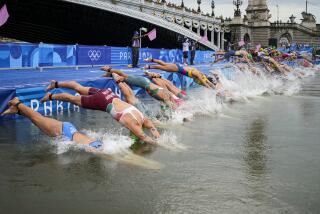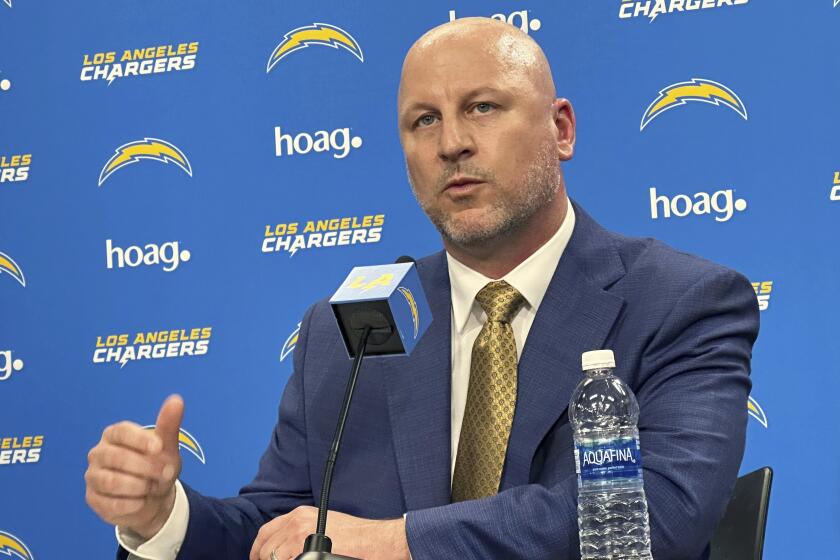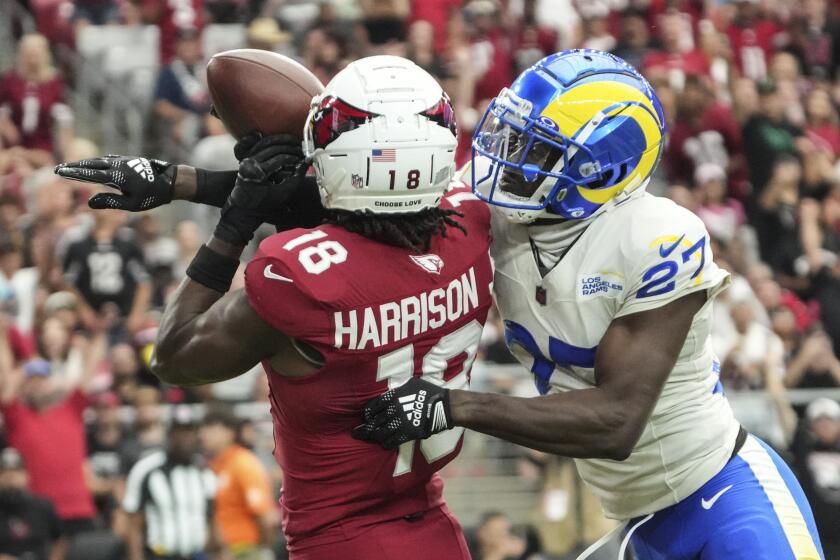Older Triathletes in It for the Long Run, Swim and Ride
At an age when many are thinking bingo, Peggy McDowell-Cramer and Loren Leonard are thinking buff. McDowell-Cramer, 60, a Presbyterian minister in Santa Monica, and Leonard, a 72-year-old retired electronics engineer from Hawthorne, are in training for the grueling Ironman Triathlon World Championship set for Saturday in Kailua-Kona, Hawaii.
What makes them run (26.2 miles), bike (112 miles) and swim (2.4 miles) in this, the Rolls-Royce of triathlons? It’s not money--only the 126 professionals among about 1,500 competitors will be vying to divide the $325,000 purse. For Leonard, who’d never even run a 5K until he was 52, it’s partly curiosity--”How far can I take it?”--and partly pride. “You have a great ego boost when you beat some young stud.”
McDowell-Cramer says, “It changes people’s perception of me,” including her family’s. “It gives you an enormous amount of confidence” to finish an Ironman, even at the back of the pack. “You haul your carcass over that finish line ... that’s something no one can take away from you.”
Leonard will be competing in the annual event on the Big Island for the fifth time and only once has he failed to finish within the 17-hour time limit. “I didn’t make it in 1995. The wind came up something fierce. People were getting knocked off their bicycles” as they pedaled through the lava fields on Queen Kaahumanu Highway. He stayed on his bike but missed the cutoff time for finishing by about half an hour. “As I was coming back in, my legs started to tie up.” He smiles and says, “It happens in my age group.”
That age group is 70 to 74, not the oldest group of competitors. There are two entrants, both men, in the 75-to-79 group. In his group, Leonard will be vying for glory against 11 other men. There’s a lone female competitor in the division--Madonna Buder of Spokane, Wash.--who, it would seem, is a shoo-in to win the women’s trophy.
McDowell-Cramer will be competing for the third time in Kona, an event sponsored by the Florida-based World Triathlon Corp. In 1998, her first year, she had two bike crashes. She was badly bloodied in a tangle with a Swiss biker and later was swept off her bike by the wind. Despite a few cracked ribs, she persevered, missing the cutoff time by only 11 minutes, which made it fruitless to attempt the final event, the marathon.
As an ordained minister, she says, “I wasn’t overly compelled to hop up and say, ‘The Lord has done wonderful things for me in this race.’ Church was over, as we say in the trade.” Humbled but undeterred, she returned the next year and finished in 16 hours, 39 minutes. “Success certainly urges one on,” says McDowell-Cramer, who was introduced to triathlons when her sister persuaded her to enter one for women sponsored by Danskin, the women’s dance wear manufacturer, in San Jose in 1992. She placed fourth. And she was hooked.
When Leonard retired in 1985 from Hughes Aircraft, he “really got into this stuff. Now it’s a way of life.” His weekly training routine includes swimming 5,000 yards at the Spectrum Club in Manhattan Beach, five hours biking and 30 miles running. His training partner is his wife, Charlene, who does not compete because of a vision problem.
Wiry and tanned, Leonard is a fit 5 feet 6 and 150 pounds. But that wasn’t always the case. A smoker for 20 years, he quit when he was 37 and, he says, “I got fat in my 40s.” When he was 52, he realized he could no longer walk upstairs without discomfort, and “that’s when I started exercising.”
McDowell-Cramer, who’s always been athletic, was in synchronized swimming national competitions in the ‘60s. Swimming is still her strongest event--she trains in the ocean at Santa Monica. Biking and running along San Vicente Boulevard are also part of her six-day-a-week training schedule.
On a recent day, she hit the beach--wetsuit, goggles and yellow cap in place--and ducked under the waves in a gray-green ocean. But the surf was too rough for serious swimming, and she cut her planned 30-minute workout in half. “Compared to this,” she said, “Kona’s a piece of cake.” It’s also a lot warmer. She also competes in such far-flung places as Wellington, New Zealand, and hopes to qualify for the Cancun, Mexico, 2002 world championships, both under the auspices of another sponsoring group, the International Triathlon Union.
A self-described “itinerant” pastor--McDowell-Cramer has no flock but is, rather, a teaching minister--she conducts impromptu services for competing athletes. She’ll simply find a church near the headquarters hotel, call and say, “Hello, you don’t know me. May I have your church for free?”
For her, the social ambience at triathlons is a big draw. And, she says, “it’s fun to be part of the U.S. team. You feel all patriotic.” Forty-eight nations will be represented at the Hawaii event. Two competitors dropped out after the Sept. 11 attacks on New York and the Pentagon--a firefighter from Long Island and a German who was fearful of making the trip.
At 60, McDowell-Cramer says, she loves proving “that I can do it.” She shrugs off the chance of losing. “My family will still love me. My life doesn’t change.” Her husband, Pat, doesn’t share her enthusiasm for triathlons. For that matter, neither did their grown son and daughter, who live in Hawaii, at the beginning.
“The kids said, ‘Mom, don’t do that.’ I think they perceived a meltdown.”
In his age group, Leonard says, there are maybe 25 men worldwide competing at this level. And, he adds, they’re starting “to get more attention.” Recently, their lobbying efforts paid off when rules were changed to allow the 70-plus contingent to wear sleeveless wetsuits for the ocean swim at Hawaii. (Triathlon rules ban wetsuits unless the water is below 72 degrees). “Older people have less body fat,” he explains, and hypothermia is a threat.
Competition is fierce for one of the 1,500 slots at the prestigious Kailua-Kona race. Athletes qualify by winning their age group at events throughout the country during the year, by lottery (200 slots) or by winning their division at the previous year’s Ironman.
As the triathlon becomes more popular at the high school and college levels, the field gets younger and, Leonard says, “there’s fewer spots available for the older guys” because more slots are allocated to the divisions with the most competitors.
His typical finish of 16-plus hours at Kailua-Kona keeps him in the competition but is about twice the time of the race winners, who are apt to clock in at under 81/2 hours for men and 91/2 hours for women.
On Saturday, competitors will be up early for a 7 a.m. start. McDowell-Cramer will start the day with her usual: three instant breakfasts. During the race, Leonard will be consuming sports drinks and ice water--both of which will be available at intervals along the race routes--as will salted boiled potatoes for a quick carb-and-salt fix, candy, pretzels, cookies and fruit.
“A successful racer budgets his body,” says Leonard. “You’ve got to eat right, drink right, pace yourself.” That takes experience, he knows, and “most of the old guys come out of it in pretty good shape. As you get older, you get smarter.”
He usually feels just fine the day after. “The adrenaline carries you a long way, but two or three days after the race, you’re really trashed.” While training in 1995, he had a real scare. “I couldn’t get enough air in my system.” Although his doctor could find nothing wrong, it would be two years before he was back in shape.
McDowell-Cramer, who has been nursing a pulled muscle while training for Hawaii, says, “You’re always one injury away” from the end of competing. During a race, she keeps a comb tucked into a back pocket for a little primping before the finish line. “Even if I die 20 feet on the other side,” she says, she wants to die looking good.
Competitors pay for their own travel and entry fees--$382 in Hawaii. The bikes are also costly. Leonard spent about $2,000 on a vibration-free Kestrel 500 lightweight carbon fiber bike that he describes as “like riding in a BMW.”
At Kailua-Kona, Alii Drive will be lined with well-wishers as racers head for the finish line. “It’s electrifying,” says McDowell-Cramer, “the entire town focused on these 1,500 people. I’m sure they think, ‘Oh, the poor old dear ....”’
As for Leonard, he’s thinking about improving, not about quitting. “I’m still getting better,” he says, except at running. “I’m interested in how long an older person can continue to improve. They’re still setting records in my age group.”
More to Read
Go beyond the scoreboard
Get the latest on L.A.'s teams in the daily Sports Report newsletter.
You may occasionally receive promotional content from the Los Angeles Times.










